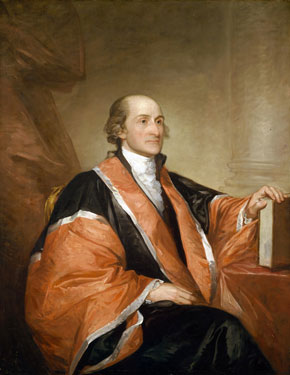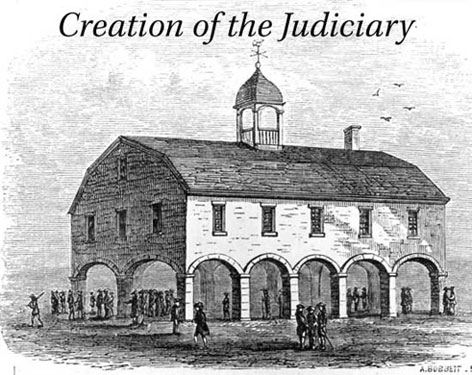26a. The Establishment of the Federal Judiciary
Located: 1st floor hallway at courthouse and federal building linkPrints in courthouse exhibit: Map of original Judicial Circuits; portrait of John Jay, first Chief Justice of the U.S. Supreme Court; and a print of the Old Royal Exchange in New York.
On June 21, 1788, New Hampshire became the ninth state to ratify the United States Constitution, establishing it as the law of the land. In the wake of this momentous event, there remained differing opinions about how to organize a judicial system to best serve the new nation. The constitutional plan for three independent and co-equal branches of government, which was intended to assure a balance of power, necessarily anticipated a strong federal judiciary.

Establishment of the Federal Judiciary
On June 21, 1788, New Hampshire became the ninth state to ratify the United States Constitution, establishing it as the law of the land. In the wake of this momentous event, there remained differing opinions about how to organize a judicial system to best serve the new nation. The constitutional plan for three independent and co-equal branches of government, which was intended to assure a balance of power, necessarily anticipated a strong federal judiciary. The question whether to establish just one or many federal courts, however, remained undecided. As the result of compromise in the framers’ deliberations, Article III of the Constitution permitted, but did not require, the creation of lower federal courts:
The judicial Power of the United States shall be vested in one Supreme Court, and in such inferior Courts as the Congress may from time to time ordain and establish.
After extended debate concerning the reach of the new national government, the First Congress authorized a system of lower federal trial and quasi-appellate courts under the Judiciary Act of 1789.
The Act divided the nation into thirteen judicial districts, largely along state lines. Since North Carolina and Rhode Island had not yet joined the union by ratifying the Constitution, they were not initially given judicial districts. Maine, then a part of Massachusetts, and Kentucky, then a part of Virginia, were constituted as districts separate from their states. A lasting precedent was established, that no judicial district should overlap a state boundary. A judge appointed for each district would hold court four times a year to hear admiralty cases, forfeiture cases, and lesser civil and criminal cases arising under federal law. In New Hampshire, these district court sessions alternated between Portsmouth and Exeter, hubs of the revolutionary era.
The Judiciary Act of 1789 also created three regional circuits (Eastern, Middle, and Southern). New Hampshire, Maine, Massachusetts, Connecticut, and New York comprised the Eastern Circuit. Most complex trials, and appeals from the district courts, were heard by a panel of two Supreme Court Justices (later, just one), who twice annually “rode the circuit” by horseback, carriage, or boat to join the local district judges, thus comprising the circuit courts. The first Chief Justice of the United States Supreme Court, John Jay, a resident of New York, was among those who journeyed to New Hampshire to hear circuit court cases. The requirement of “circuit-riding” meant that the Justices were away from home for months at a time each year. Despite the inconvenience, discomfort and dangers of extended travel in that era, the generally despised practice remained a regular duty of Supreme Court Justices until 1891.
The Chief Justice and five Associate Justices of the Supreme Court also met twice a year in the nation’s capital (originally, New York City) to hear appeals from circuit courts and state supreme courts, and to exercise the Court’s limited original jurisdiction. The first session of the United States Supreme Court took place on February 1, 1790, on the second floor of the Old Royal Exchange, a covered New York City marketplace. The Court met there for a total of twelve days before moving to the new capital city of Philadelphia in 1791.
Like many of the founders’ decisions, the original Judiciary Act was a bold and innovative experiment. Consistent with the new constitutional structure, it was fully steeped in federalism. The nation’s judiciary was purposefully tethered to the concerns of the states by the convening of its lower courts within their borders. Federal district judges, court staff, and jurors were all local residents with local perspectives. Equally important, the state courts retained authority to decide matters not specifically delegated to the national government.
Few observers could have confidently predicted that the co-existence of distinct federal and state court systems within each state’s boundaries would so successfully persevere under the broad outline set forth by the framers of the Constitution and the Judiciary Act of 1789. While the dual court systems have developed over time, their foundations have remained unshaken, ensuring both the preservation of states’ rights and the consistent application of federal law across the nation.








